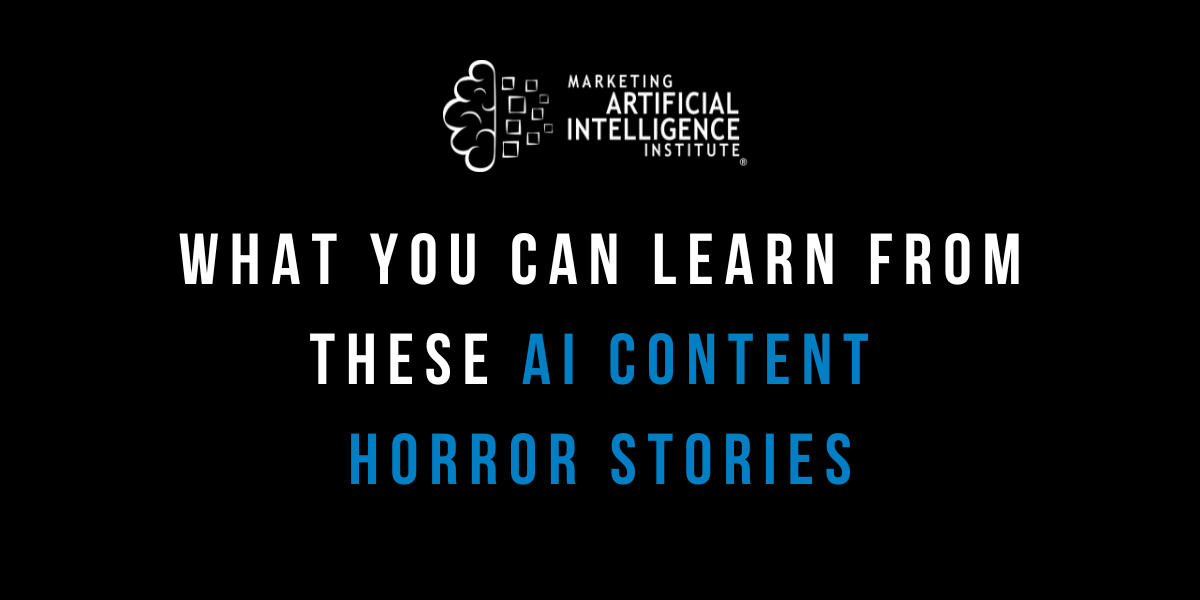A series of horror stories show the dangers of misusing AI for content creation.
- AI-generated content farms are flooding the internet with crap articles…
- Tech site Gizmodo gets caught publishing inaccurate AI-generated content—pissing off employees and fans…
- And a leaked email shows one publication’s plan to replace over 100 jobs with AI…
Unfortunately, these are just a handful of recent stories we’re tracking that show how prevalent misuse of AI-generated content is becoming—even from media companies and brands that should know better.
Why it matters: This sad state of affairs is a masterclass in how not to use AI in content and media—and we can learn a lot from it. (Even if it drives us crazy.)
Connecting the dots: In Episode 54 of the Marketing AI Show, Marketing AI Institute founder/CEO Paul Roetzer explained to me what marketers and business leaders need to keep in mind about AI–generated content.
- This bad behavior is likely explained by incentives. “I think there’s a lot of financial pressure on these media outlets,” says Roetzer. “There’s probably a lot of push to drive efficiency and reduce reliance on human writers.” If outlets think they can generate ad revenue by publishing crap content, there’s likely a high motivation to do that.
- But that’s a losing strategy. This recent batch of horror stories show how ill-advised this strategy is. “It destroys the trust of the audience,” says Roetzer. And it does so almost immediately, once inaccuracies or quality issues with AI-generated content come to light. It’s pretty obvious this path doesn’t end well for the companies involved.
- It also reveals failings at the leadership level. “Either they don’t understand how the tech works and that it makes stuff up or they don’t care,” says Roetzer. “Neither of those looks good.”
- Put simply, companies should not be replacing writers with AI. These stories make it pretty obvious: Purely AI-generated content without guardrails destroys brand value. Content farming for ad dollars is a terrible strategy and business model. And replacing staff with AI tools that run without human oversight is bad for business.
How to take action: Use AI to support the creation of great content. AI can dramatically improve the productivity and creativity of tasks like: ideation, curation, outlining, first drafts, editing, and polishing. “But don’t think you can take humans out of the loop,” says Roetzer.
Don’t get left behind…
You can get ahead of AI-driven disruption—and fast—with our Piloting AI for Marketers course series, a series of 17 on-demand courses designed as a step-by-step learning journey for marketers and business leaders to increase productivity and performance with artificial intelligence.
The course series contains 7+ hours of learning, dozens of AI use cases and vendors, a collection of templates, course quizzes, a final exam, and a Professional Certificate upon completion.
After taking Piloting AI for Marketers, you’ll:
- Understand how to advance your career and transform your business with AI.
- Have 100+ use cases for AI in marketing—and learn how to identify and prioritize your own use cases.
- Discover 70+ AI vendors across different marketing categories that you can begin piloting today.
Mike Kaput
As Chief Content Officer, Mike Kaput uses content marketing, marketing strategy, and marketing technology to grow and scale traffic, leads, and revenue for Marketing AI Institute. Mike is the co-author of Marketing Artificial Intelligence: AI, Marketing and the Future of Business (Matt Holt Books, 2022). See Mike's full bio.




